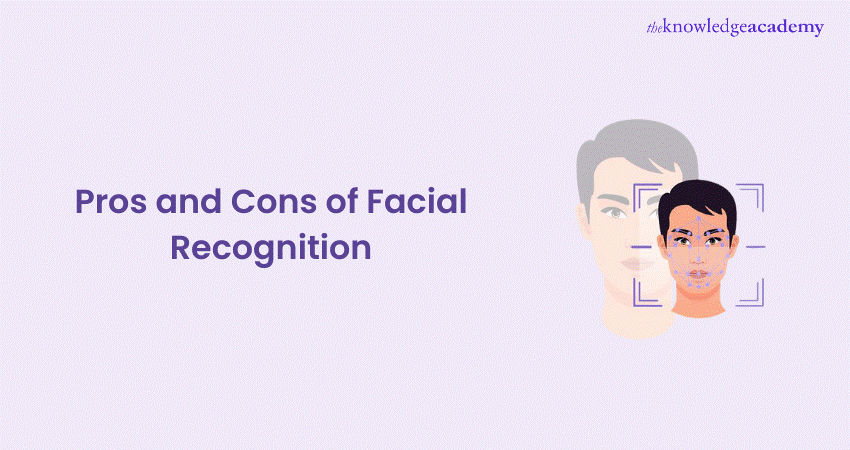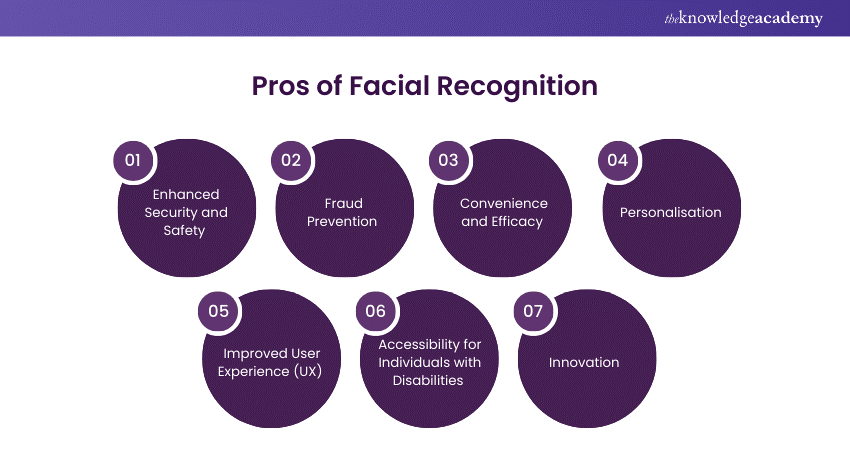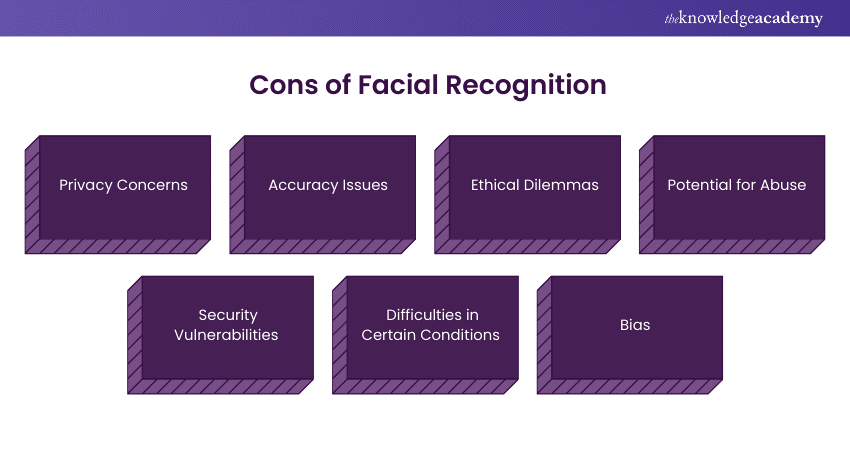We may not have the course you’re looking for. If you enquire or give us a call on +44 1344 203999 and speak to our training experts, we may still be able to help with your training requirements.
Training Outcomes Within Your Budget!
We ensure quality, budget-alignment, and timely delivery by our expert instructors.

Have you ever wondered if the convenience of Facial Recognition comes at a cost? This wonderful technology is rapidly changing the way we interact with the world, from unlocking our phones to securing buildings. But with the technology’s increasing prevalence, it's crucial to understand the Pros and Cons of Facial Recognition.
This comprehensive blog dives deep into both sides of the coin. We'll explore the undeniable benefits of Facial Recognition, like enhanced security and missing person identification. But we'll also examine the potential drawbacks, such as privacy concerns and racial bias. By the end of this blog, you'll be equipped to understand the Pros and Cons of Facial Recognition and make informed decisions about the technology. So, is Facial Recognition a boon or a bane? Let's find out together!
Table of Contents
1) What is Facial Recognition?
2) Why is Facial Recognition Important?
3) How is Facial Recognition Used?
4) Pros of Facial Recognition
5) Cons of Facial Recognition
6) Conclusion
What is Facial Recognition?
Facial Recognition is an identity verification technology that identifies or verifies a person by analysing and comparing patterns based on their facial features. This technology incorporates algorithms and machine learning (ML) to map facial landmarks, including the distance between the eyes, the shape of one’s cheekbones, and the contour of the lips, to create a unique digital template of an individual's face. These templates are then stored in databases and used to match against live images or video feeds to confirm identity.
Facial Recognition systems can be deployed through various devices, including cameras, smartphones, and security systems, making it a versatile tool for numerous applications. The process involves capturing a facial image, extracting its unique features, and comparing it to a pre-existing database to find a match. The technology has advanced significantly, leveraging artificial intelligence (AI) and deep learning to improve accuracy and speed.
Why is Facial Recognition Important?
Facial Recognition has become popular for its ability to enhance security measures. Companies use it to secure restricted areas, such as laboratories or rooms with valuable equipment, protecting assets and data from potential theft.
In sectors like banking, government, and law enforcement, Facial Recognition is utilised for surveillance, border control, and crime prevention, aiding in the identification and apprehension of individuals involved in illicit activities.
In healthcare, face detection is crucial for accurately identifying patients and accessing their medical records instantly. This capability allows healthcare providers to deliver personalised care and streamline administrative tasks.
Additionally, Facial Recognition systems can assist in diagnosing certain medical conditions by analysing facial cues and expressions, potentially enabling earlier detection and treatment.
How is Facial Recognition Used?
Facial Recognition technology is employed in diverse fields, offering a range of applications that enhance security, convenience, and personalisation. Some of the common uses include:
a) Finding Missing People: In law enforcement, Facial Recognition systems assist in locating missing individuals. Paired with street surveillance or traffic cameras, these systems can identify a single face in large crowds. The International Network of Associations of Disappeared Persons utilises volunteers equipped with Facial Recognition software on their smartphones to search for missing persons.
b) Organising Photos by Face: Modern smartphones from Google and Apple can automatically sort photos in a user’s library by Facial Recognition. Google Photos offers a face grouping feature, while Apple’s Photos app includes a People & Pets feature for this purpose.
c) Access to Transportation: The Transportation Security Administration (TSA) employs Facial Recognition to match travellers' images with their identification documents at airports, enhancing security and efficiency.
d) Access to Personal Devices: Many Apple devices use the Face ID feature for Facial Recognition to unlock smartphones, allowing users to log in without a PIN or password. Apple claims there's less than a one-in-a-million chance of a random person unlocking another's iPhone with Face ID.
e) Biometric Verification for Online Applications: Facial Recognition is used by various online platforms for user identification. For instance, DoorDash requires drivers to verify their identity with a selfie before delivering food.
f) Medical Treatment: Facial Recognition aids in early illness detection. Applications like Face2Gene help doctors diagnose genetic disorders by using AI and deep learning to match facial features associated with these conditions.
g) Filing Taxes: The IRS has previously used Facial Recognition to authenticate taxpayers' online accounts. However, they moved away from third-party Facial Recognition software due to privacy concerns.
h) Keyless Guest Room Entry at Hotels: Facial Recognition is gaining popularity in the hotel industry for automated check-ins. The Vinpearl Nha Trang hotel chain uses Facial Recognition-powered check-in systems for a seamless guest experience.
i) Targeted Marketing: Facial Recognition systems can personalise marketing by analysing consumers’ facial data. For example, Walgreens installed smart coolers with Facial Recognition cameras to detect shoppers' age and gender, displaying targeted ads based on this data.
j) Social Media: Platforms like TikTok, Snapchat, and Instagram use Facial Recognition for face filters, allowing users to take augmented selfies. Additionally, these platforms can automatically suggest profiles to tag in photos.
k) Accessibility: Facial Recognition enhances accessibility by describing photos to visually impaired users, including details about the people in the photos and their expressions.
l) Contactless Building Entry: Facial Recognition provides contactless authentication for building entry, reducing touchpoints and ensuring adherence to health protocols, especially during the COVID-19 pandemic.
Become a leader in biometric technology—Register for our our Face Recognition Training and harness the power of advanced AI techniques today!
Pros of Facial Recognition
Let us look at some prominent benefits of Facial Recognition:

1) Enhanced Security and Safety
Facial Recognition technology significantly enhances security by enabling real-time monitoring and identification of individuals in public and private spaces. It helps prevent unauthorised access, detect potential threats, and ensure overall safety.
2) Fraud Prevention
By providing a robust method of identity verification, Facial Recognition helps prevent fraud in various sectors, including banking, finance, and e-commerce. It greatly reduces the risk of identity theft and ensures secure transactions.
3) Convenience and Efficacy
Facial Recognition offers a convenient way to authenticate identity without the need for physical keys, passwords, or PINs. It simplifies everyday activities, such as unlocking devices, making payments, and accessing accounts.
4) Personalisation
The technology enables personalised experiences by recognising individuals and tailoring services to their preferences. In retail and hospitality, Facial Recognition enhances customer satisfaction by providing customised recommendations and services.
5) Improved User Experience (UX)
Facial Recognition enhances the user experience (UX) by offering a seamless and effective way to verify identity. It reduces the need for manual checks and streamlines various processes, improving overall efficiency.
6) Accessibility for Individuals with Disabilities
Facial Recognition technology provides an accessible means of identity verification for individuals with disabilities, offering an alternative to traditional methods that may be challenging for some users.
7) Innovation
The adoption of Facial Recognition drives innovation across various industries, leading to the development of new applications and improving existing services. It fosters technological advancement and enhances overall operational efficiency.
Unlock the future of technology—Sign up for our Face and Speech Recognition Courses and lead the way in innovative AI solutions!
Cons of Facial Recognition
While Facial Recognition has been largely beneficial, it also poses some problems and drawbacks:

1) Privacy Concerns
Facial Recognition raises significant privacy issues, as it it pertains to the collection and storage of biometric data. There are concerns about how this data is used, stored, and potentially misused by organisations or government agencies.
2) Accuracy Issues
Despite advancements, Facial Recognition technology can still face accuracy challenges, particularly in cases of poor image quality, changes in appearance, or identical twins. Misidentifications can lead to serious consequences, especially in security and law enforcement contexts.
3) Ethical Dilemmas
The use of Facial Recognition technology presents ethical questions related to consent, surveillance, and the potential for discriminatory practices. It is essential to balance technological benefits with ethical considerations to ensure responsible use.
4) Potential for Abuse
There is a risk that Facial Recognition technology could be misused for unauthorised surveillance, tracking, or profiling of individuals without their consent. This potential for abuse necessitates strict regulations and oversight.
5) Security Vulnerabilities
Facial Recognition systems can be susceptible to hacking and spoofing attacks, where unauthorised individuals attempt to gain access using photos, videos, or 3D masks. Ensuring robust security measures is critical to prevent such breaches.
6) Difficulties in Certain Conditions
The effectiveness of Facial Recognition can be compromised in certain conditions, such as low light, extreme angles, or partial obstructions. These limitations can affect the reliability of the technology in real-world scenarios.
7) Bias
Facial Recognition algorithms can exhibit biases based on race, gender, and age, leading to unequal treatment and inaccuracies. Addressing these biases is crucial to ensure fair and equitable use of the technology across diverse populations.
Master computer vision—join our OpenCV with Python Training and start building cutting-edge image processing applications today!
Conclusion
The verdict on Facial Recognition? It's a complex issue. Understanding both the pros and cons of Facial Recognition is essential for utilising this powerful technology. Facial Recognition can offer significant advantages, but ethical considerations require careful attention. Ultimately, the future of Facial Recognition hinges on responsible development and implementation
Frequently Asked Questions

The most important aspect of Facial Recognition is accuracy. This depends on high-quality image capture, robust algorithms, and comprehensive databases to ensure precise identification and verification, minimising errors and false matches.

Facial Recognition typically takes just a few seconds. Modern systems are designed to quickly capture, analyse, and match facial data, ensuring swift identification and verification processes for various applications.

The Knowledge Academy takes global learning to new heights, offering over 30,000 online courses across 490+ locations in 220 countries. This expansive reach ensures accessibility and convenience for learners worldwide.
Alongside our diverse Online Course Catalogue, encompassing 17 major categories, we go the extra mile by providing a plethora of free educational Online Resources like News updates, Blogs, videos, webinars, and interview questions. Tailoring learning experiences further, professionals can maximise value with customisable Course Bundles of TKA.

The Knowledge Academy’s Knowledge Pass, a prepaid voucher, adds another layer of flexibility, allowing course bookings over a 12-month period. Join us on a journey where education knows no bounds.

The Knowledge Academy offers various Face and Speech Recognition Courses, including the CMUSphinx Training, Face Recognition Training and the OpenCV With Python Training. These courses cater to different skill levels, providing comprehensive insights into Differences Between AI and RPA Technologies.
Our Advanced Technology Blogs cover a range of topics related to Face Recogtion, offering valuable resources, best practices, and industry insights. Whether you are a beginner or looking to advance your Advanced Technology skills, The Knowledge Academy's diverse courses and informative blogs have got you covered.
Upcoming Advanced Technology Resources Batches & Dates
Date
 Face Recognition Training
Face Recognition Training
Thu 30th Jan 2025
Thu 20th Mar 2025
Thu 8th May 2025
Thu 17th Jul 2025
Thu 25th Sep 2025
Thu 6th Nov 2025
Thu 13th Nov 2025







 Top Rated Course
Top Rated Course



 If you wish to make any changes to your course, please
If you wish to make any changes to your course, please


